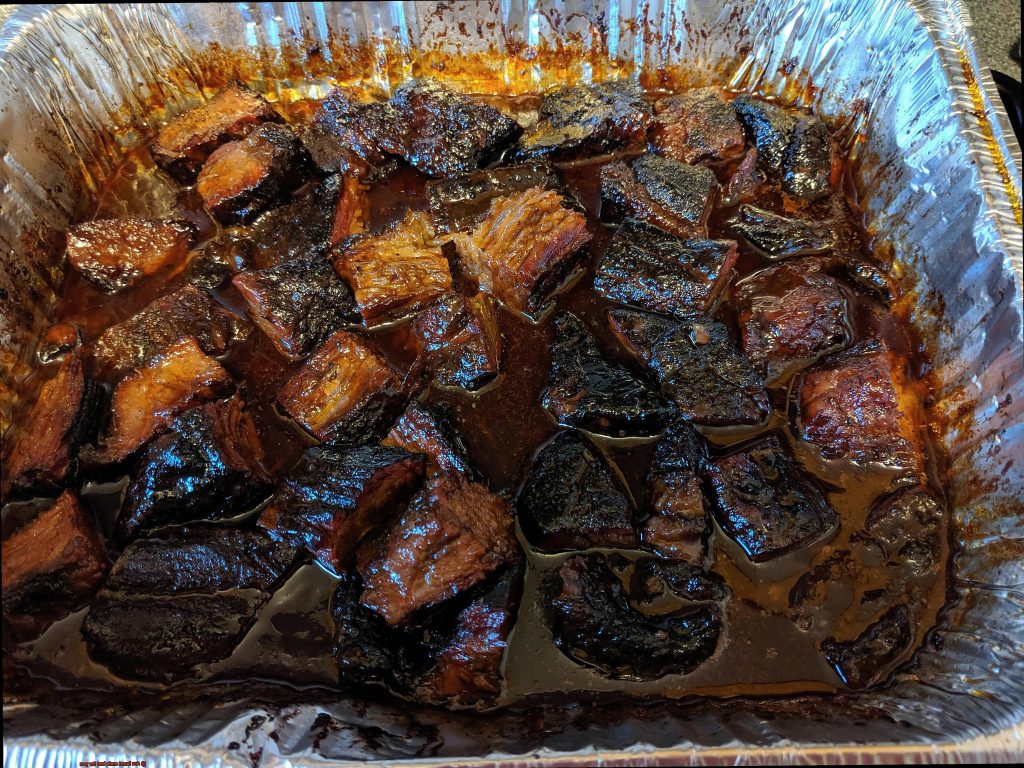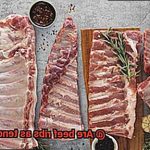Have you ever sunk your teeth into a perfectly charred and smoky piece of burnt ends? If you have, then you know why this BBQ delicacy is so popular. But if you’re wondering whether it’s a guilty pleasure or a healthy choice, you’re not alone. The question remains: are burnt ends bad for you?
As an expert in the food industry, I’ve done my research and tasted my fair share of burnt ends to bring you the answer. And let me tell you, it’s not as straightforward as it seems. On one hand, burnt ends are packed with protein and essential amino acids that can benefit your body. But on the other hand, they’re also loaded with fat, calories, and sodium that can wreak havoc on your health if consumed too much.
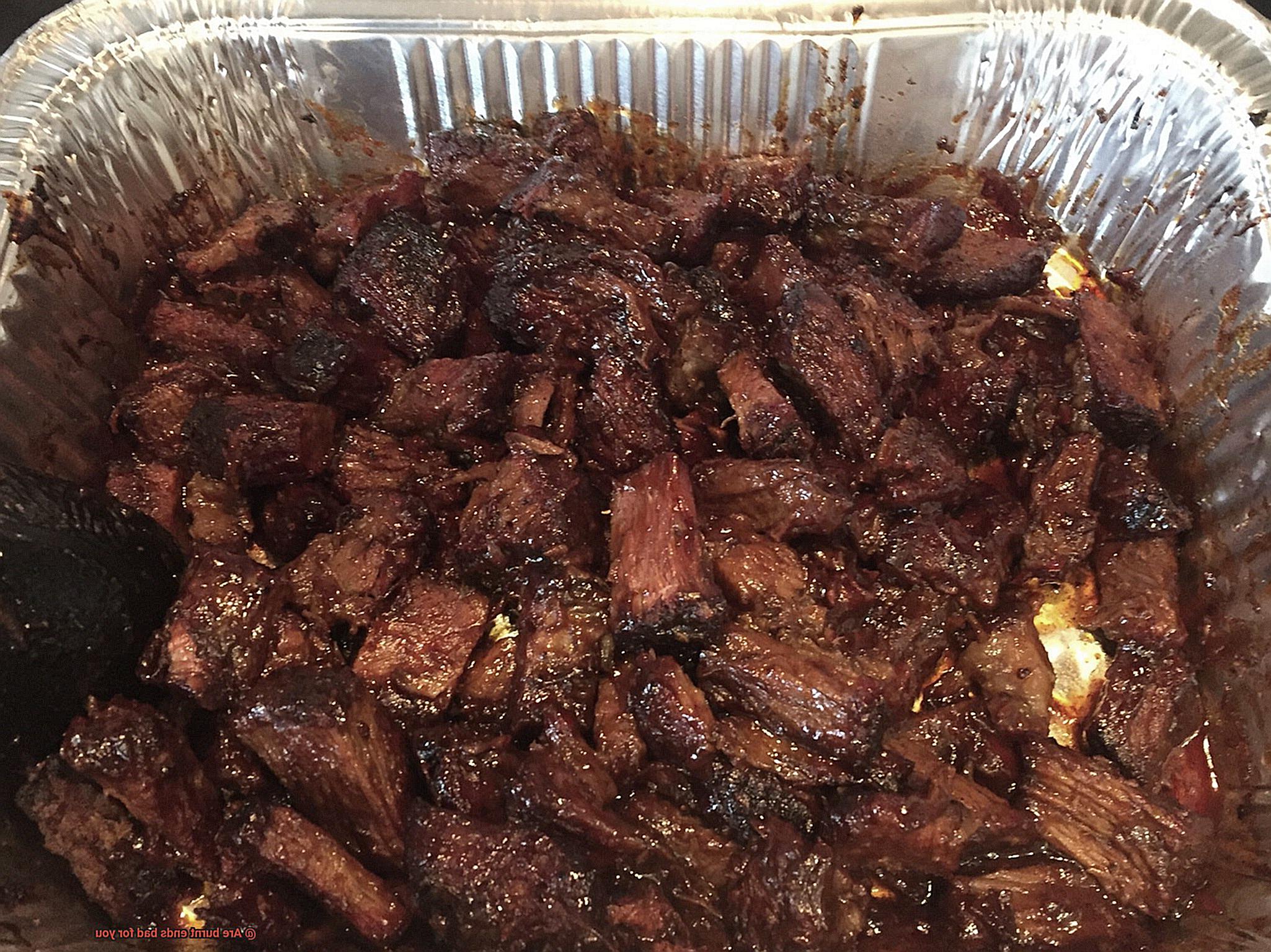
In this blog post, we’ll dive deep into the world of burnt ends to uncover the truth about their nutritional value and potential health risks. We’ll also share some tips on how to make them a healthier option without sacrificing flavor. Whether you’re a die-hard fan or a curious newcomer to this beloved dish, get ready to learn everything there is to know about burnt ends.
Contents
Nutritional Value of Burnt Ends
While these meat bites are undoubtedly delicious, it’s important to consider their nutritional value and potential health risks.
Burnt ends are made from the fatty ends of brisket that have been smoked for an extended time, resulting in a crispy exterior and juicy interior with an intense smoky flavor. However, this process also leaves them high in calories and fat. A typical serving of burnt ends can contain up to 500 calories and 40 grams of fat, making them a potential contributor to weight gain and heart disease if consumed excessively.
Furthermore, burnt ends are low in essential nutrients such as fiber, vitamins, and minerals that are vital for optimal bodily function. Regular consumption of burnt ends can lead to nutrient deficiencies over time.
But fear not. There are ways to enjoy burnt ends while minimizing their negative impact on your health. Using leaner cuts of meat and trimming off excess fat before cooking can help reduce the overall fat content. Additionally, cooking at lower temperatures for longer periods of time can minimize the formation of harmful compounds.
While consuming burnt ends occasionally as part of a balanced diet is unlikely to cause harm, moderation is still key. Incorporating more nutrient-dense foods into your diet is crucial for maintaining optimal health. Consider pairing your burnt ends with a side of grilled vegetables or a salad to balance out your meal.
Potential Health Risks Associated with Eating Burnt Ends
Before you indulge in your next plate, it’s crucial to be aware of the potential health risks associated with this meaty treat.
One of the most significant risks is the formation of polycyclic aromatic hydrocarbons (PAHs) and heterocyclic amines (HCAs) during the cooking process. PAHs are formed when meat is cooked at high temperatures, resulting in charring or blackening of the meat. These compounds have been linked to several types of cancer, including lung, skin, and bladder cancer. HCAs, on the other hand, are formed when meat is cooked over an open flame or at high temperatures and have been linked to colon, stomach, and breast cancer.
In addition to cancer risk, consuming burnt ends regularly may increase the risk of heart disease. According to the American Heart Association, consuming too much red meat – especially processed meats like burnt ends – can increase cholesterol levels and lead to heart attacks and strokes.
But that’s not all – improperly cooked burnt ends can also contain harmful bacteria that can cause food poisoning and other illnesses. It’s crucial to ensure that your meat is cooked thoroughly and at the right temperature to reduce the risk of bacterial contamination.
So how can you still enjoy burnt ends while minimizing these risks? Here are some tips:
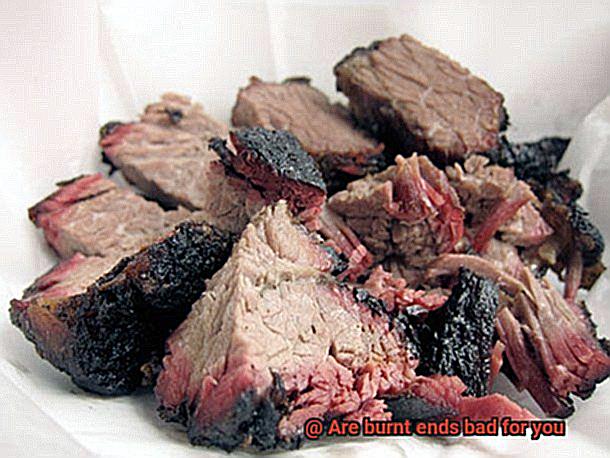
- Use leaner cuts of meat to reduce the production of PAHs and HCAs.
- Cook at lower temperatures for longer periods to reduce charring and blackening.
- Marinate your meat before cooking to add flavor while also reducing the formation of harmful compounds.
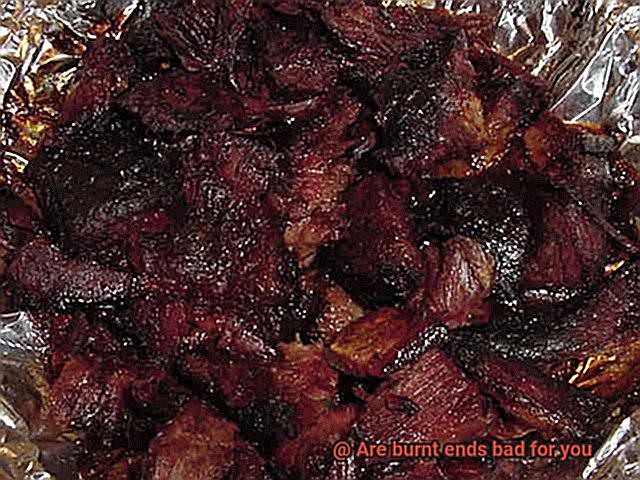
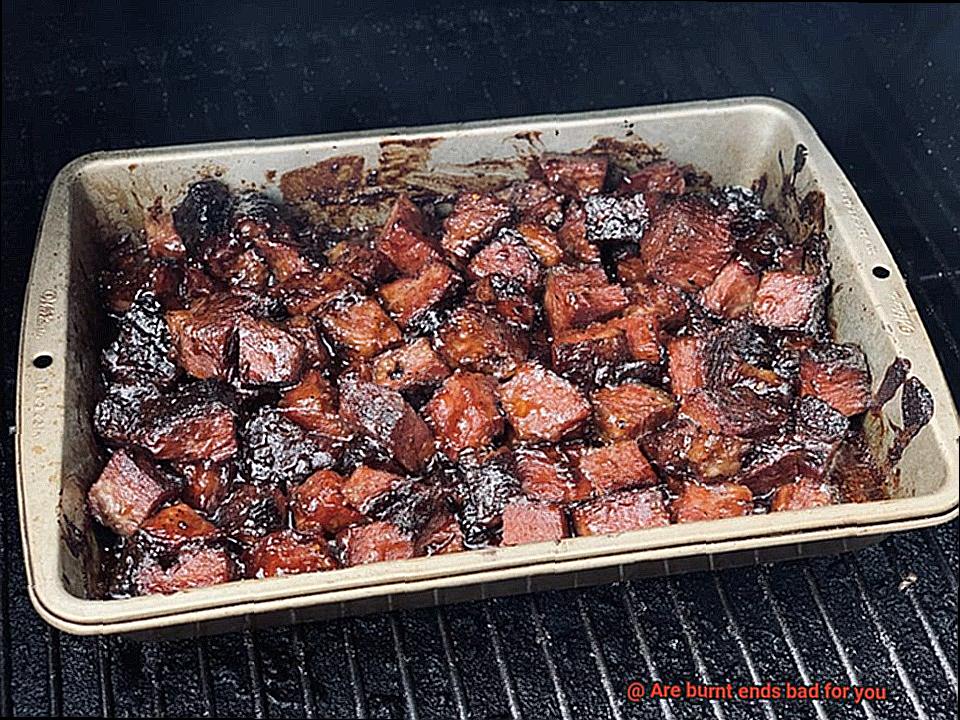
How to Make Burnt Ends Healthier
These little bites of heaven are packed with high fat and added sugars, making them a less-than-ideal food choice. However, fret not, there are ways to make burnt ends healthier without compromising on their flavor.
Opt for Leaner Cuts of Meat
To reduce the overall fat content of the dish while still providing a rich, meaty flavor, try using leaner cuts of meat such as sirloin or tri-tip instead of a brisket. These cuts are lower in fat and calories but still retain their flavor when cooked correctly. In addition, using a leaner cut of meat can help reduce the risk of heart disease and other health issues associated with high-fat diets.
Trim Off Excess Fat Before Cooking
While a little fat is necessary to keep the meat moist and tender, too much can be detrimental to your health. Removing visible fat before cooking can also help prevent flare-ups and reduce the amount of smoke produced during cooking, which can lower your risk of lung irritation. This step can help you enjoy your favorite BBQ dish without any guilt.
Experiment with Different Cooking Methods
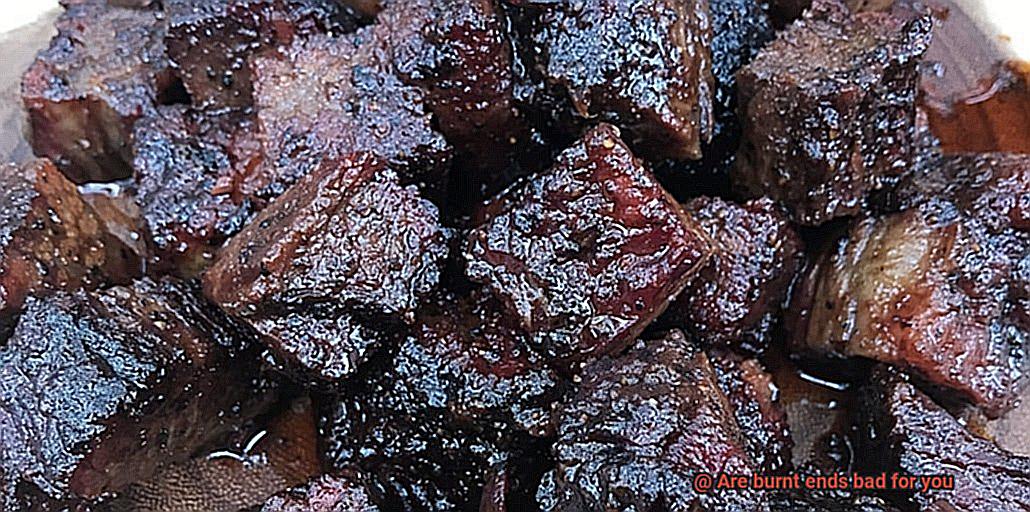
Instead of smoking them for hours on end, try grilling them over high heat for a shorter period of time. This method helps render out some of the fat while still achieving that signature crispy exterior. Using a marinade or dry rub can also add flavor without adding extra calories. Grilling or smoking the meat instead of frying it can make burnt ends healthier by reducing the amount of added oils and fats.
Use Sugar-Free or Low-Sugar Sauces
Most BBQ sauces available in stores are high in sugar content, so it is essential to read labels carefully or make your own sauce using natural sweeteners like honey or maple syrup. Using a low-sugar or sugar-free sauce can help reduce the amount of added sugars in the dish without compromising on taste. This way, you can enjoy your burnt ends without worrying about the health implications.
Serve with Healthy Sides
To balance out the meal and provide additional nutrients, serve burnt ends with healthy sides like grilled vegetables or a salad. This can help make up for any potential health drawbacks of the burnt ends themselves.
Moderation and Portion Control When Eating Burnt Ends
We all can agree that burnt ends are one of the most delicious treats out there, but it’s essential to practice moderation and portion control to avoid negatively impacting your health.
To start, moderation is key. Indulging in burnt ends every now and then is alright, but making them a regular part of your diet can lead to weight gain and other health problems. So, be mindful when consuming them.
Portion control is also crucial. Instead of piling your plate high with burnt ends, limit yourself to a small serving size. This will allow you to savor each bite without overindulging.
If you’re concerned about the health implications of burnt ends, there are ways to make them healthier. Choosing leaner cuts of meat such as pork loin or sirloin over fattier cuts like brisket can significantly reduce the amount of saturated fat and calories in each serving. This means you can still enjoy the rich flavor of the meat without compromising your health.
Pairing burnt ends with healthy sides like grilled vegetables or a salad can also balance out the meal and provide additional nutrients. This helps make the meal more satisfying overall, so you’re less likely to overindulge in the burnt ends themselves.
Benefits of Eating Burnt Ends in Moderation
If so, you might be surprised to know that there are actually some benefits to eating them in moderation. While many people assume that burnt ends are unhealthy and should be avoided altogether, the truth is that they can be a great addition to your diet when consumed in moderation.
First and foremost, burnt ends are an excellent source of protein. The beef used to make burnt ends is typically a high-quality cut, like brisket or sirloin, which means you’re getting a healthy dose of protein with every bite. Protein is essential for building and repairing muscle tissue, so if you’re looking to bulk up or recover from a tough workout, burnt ends might just be the perfect post-gym snack.
But that’s not all. Burnt ends also contain healthy fats that can support overall bodily functions and boost energy levels. However, it’s important to note that burnt ends should still be consumed in moderation due to their high fat content. If you pair your burnt ends with some nutritious sides like roasted veggies or a salad, you can enjoy the mouthwatering flavor without compromising your health.
In addition to their protein and healthy fat content, burnt ends also offer antioxidant properties. When meat is cooked at high temperatures (like when making burnt ends), it produces compounds called HCAs and PAHs. While these compounds can be harmful in large amounts, they also have antioxidant properties that can protect your body against damage from free radicals. So by enjoying burnt ends in moderation, you might actually be doing your body a favor.
To summarize the benefits of eating burnt ends in moderation:
High protein content for building and repairing muscle tissue
Healthy fats for supporting overall bodily functions and boosting energy levels
Antioxidant properties from HCAs and PAHs
Tips for Cooking and Enjoying Burnt Ends Safely
Here are five tips for cooking and enjoying burnt ends safely.
- Use a meat thermometer: It is vital to use a meat thermometer to ensure that the internal temperature of the brisket reaches at least 165°F before cutting off the burnt ends. This will kill any harmful bacteria that may be present in the meat.
- Cut off burnt ends carefully: When cutting off the burnt ends, make sure to use a sharp knife and avoid touching any uncooked parts of the brisket to prevent cross-contamination. This reduces the risk of foodborne illness.
- Store and reheat burnt ends properly: If you have leftovers, store them in an airtight container in the refrigerator and consume them within 3-4 days. When reheating, make sure to heat them thoroughly until they reach an internal temperature of at least 165°F to avoid bacterial growth.
- Consider using a smoker box: Using a smoker box can help prevent flare-ups and reduce the risk of burning your meat. It also adds a smoky flavor without exposing your meat to harmful chemicals from charcoal or lighter fluid.
- Don’t overcook your brisket: Overcooking your brisket can lead to burnt ends that are tough and dry, which can increase the risk of choking. Make sure to cook your brisket until it is tender but not overdone.
Different Types of Barbecue Sauces that Pair Well With Burnt Ends
Here are five different types of barbecue sauces to try:
- Kansas City style: This classic sauce is thick and sweet, made with tomato paste, molasses, and spices such as garlic and onion powder. It’s a great choice for those who love a tangy sweetness to balance out the savory meat.
- Texas style: For those who like it hot, Texas style barbecue sauce is a great choice. It’s thinner and spicier than Kansas City style, typically including chili powder, cumin, and other bold spices.
- Carolina style: If you’re looking for something unique, try a vinegar-based Carolina style barbecue sauce. It’s tangy and slightly sweet, with a hint of mustard for added depth of flavor.
- Fruit-based: For a twist on traditional barbecue sauce, experiment with fruit-based sauces such as peach or apple. These sauces add a fruity sweetness to the meat that pairs well with the smoky flavor of burnt ends.
- Mustard-based: Mustard-based sauces are popular in South Carolina and are made with yellow mustard as the base instead of tomato. They’re tangy and slightly sweet, but lower in sugar than tomato-based sauces.
No matter which type of barbecue sauce you choose, it’s important to consume them in moderation. Some sauces may be healthier than others, so make sure to check the ingredient list for added sugars or other unhealthy additives.
Alternatives to Eating Burnt Ends
While they may be a crowd favorite, consuming them regularly may not be the healthiest option for you. Burnt ends are high in fat and calories, which can lead to weight gain and other health issues like heart disease and diabetes. But don’t worry, there are plenty of delicious alternatives that won’t sacrifice flavor or nutrition.
Grilled Vegetables
Grilling vegetables like zucchini, bell peppers, and mushrooms can provide a healthy and tasty alternative to burnt ends. Not only are these veggies packed with essential vitamins and minerals, but they also add some colorful variety to your plate.
Fish
If you’re looking for a lean protein source that’s low in fat and calories, grilled fish is an excellent choice. Salmon, tuna, and tilapia are all great options that are also rich in omega-3 fatty acids, which can help reduce the risk of chronic illnesses like heart disease.
Chicken Skewers
For a filling and healthy protein source, chicken skewers or kebabs are an excellent substitute for burnt ends. Chicken is low in fat and calories but still provides essential vitamins and minerals like vitamin B6 and phosphorus.
_bRbJy-Trz0″ >
Conclusion
In conclusion, burnt ends can be a mouth-watering BBQ treat that is best enjoyed in moderation. While they do contain high levels of fat and calories, they also offer essential nutrients like protein, healthy fats, and antioxidants.
However, it’s important to keep in mind the potential health risks associated with consuming burnt ends regularly. These risks include an increased risk of cancer and heart disease.
To make burnt ends a healthier option, consider using leaner cuts of meat and trimming off excess fat before cooking. Additionally, try experimenting with different cooking methods and using sugar-free or low-sugar sauces. Pairing burnt ends with healthy sides like grilled vegetables or a salad can also help balance out their nutritional value.
Remember to practice moderation and portion control when consuming burnt ends. If you’re looking for alternatives that are both nutritious and delicious, consider trying grilled vegetables, fish, or chicken skewers.
Ultimately, the choice between indulging in burnt ends or opting for healthier alternatives is up to you.

